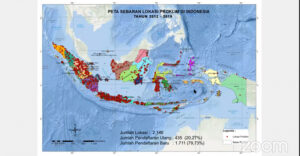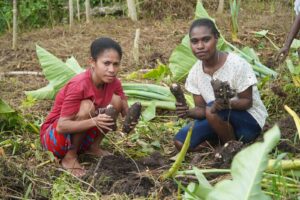
Tanah Papua holds a variety of unique and endemic flora. If there are 20,000 species of plants that come from the forests of Papua, and have the nutritional benefits contained therein. Quoted on the page science.kompas.com, Krisma Lekitoo researcher from the Manokwari Forestry Research Institute, in her book entitled “Utilization of Six Types of Fruit-Producing Forest Plant as a Source of Food in Tanah Papua”, explained that there were six types of local fruit from across the land of Papua .
Most of the fruit is obtained from the forest, which has not yet been cultivated. The six types of fruit include taer (Anisoptera thurifera), waribo / coconut forest (Borassus heineanus), piarawi / black fruit (Haplolobus monticola), gayang (Inocarpus fagifer), papua (Sararanga sinuosa), and woton (black fruit (Haplolobus monticola), gayang (Inocarpus fagifer), selre / papua (Sararanga sinuosa), and woton (black fruit (Haplolobus monticola), gayang (Inocarpus fagifer), selre / papua (Sararanga sinuosa), and woton (black fruit (Haplolobus monticola) Sterculia shillinglawii), Six types of local fruit have high nutritional potential, not least with matoa fruit (Pometia pinnata) and red fruit (Pandanus conoideus) the pride of the Land of Papua.
These native Papuan fruits are mostly from natural forests. According to the Head of the Regional Research and Development Agency (Balitbangda) of West Papua Province, as well as a lecturer at Papua State University, Charlie D Heatubun, the last paradise of biodiversity in the world is now pressured by regional development. “There has been no attention from the local government to conserve local fruits in the natural world of Papua,” he said quoted in sains.kompas.com.
In addition to these special fruits, there are many types of medicinal plants in Papua. These types of medicinal plants are also used by local people to treat diseases. In the Papua Local Medicine herbs book (2017), there are 52 types of medicinal plants classified based on the local wisdom of the Papuan people.
Like the Cassia alata L. sin plant. or in the local naming of cascade leaves, where this species is widespread in the lowlands of Papua. This plant contains pharmacological activity, which is good at curing skin diseases, such as Chysophanic acid, isochrysophanol, physcion, emodin, oleic acid, and others.
By the people of Papua this plant is used to eradicate skin diseases, especially those caused by lice or fungi. How to use this plant as a medicinal plant is to use the leaves, which are kneaded until soft and runny, then placed on the infected skin or on new wounds.
In addition, medicinal plants can also be used as traditional medicinal plants. Quoted from the official website of the Papua Provincial Health Office (Dinkes), dinkespapua.com, a number of plants that can be used as medicine must be planted in a family medicine park. Plants that need to be planted in the yard of the house, in addition to being used for daily needs, can also be used as medicine when sick.
On the site, it was explained that the Papua Provincial Health Office asked all puskesmas in districts / cities in Papua Province to improve the cultivation of family medicinal plants (toga) in the yard of the house. Besides being able to treat diseases, medicinal plants can add nutrition to the people of Papua.




